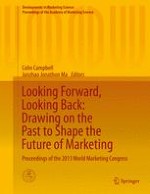2016 | OriginalPaper | Chapter
Past and Future Orientation, Environmental Attitudes and Green Consumer Behaviour
Authors : Michael Jay Polonsky, Andrea Vocino, Martin Grimmer, Morgan Miles
Published in: Looking Forward, Looking Back: Drawing on the Past to Shape the Future of Marketing
Publisher: Springer International Publishing
Activate our intelligent search to find suitable subject content or patents.
Select sections of text to find matching patents with Artificial Intelligence. powered by
Select sections of text to find additional relevant content using AI-assisted search. powered by
Some environmental degradation can be linked back to excesses in human consumption, which is one reason that marketing is frequently criticised for exacerbating the current environmental situation. Enlightened marketers are increasingly seeking to become agents of positive change, ensuring that value for consumers, the firm, society and the environment occur simultaneously. However, it is still up to consumers to modify their consumption behaviour, which is difficult given that most focus on short-term satisfaction, rather than long-term wellbeing.This paper looks at how consumers’ time orientation and environmental orientation (EO) impact on their green consumer behaviour (GCB). Literature suggests that time orientation is not a single dimension, but rather should be assessed using separate measures of past, present and future orientation. This paper uses Usunier and Valette-Florence’s (2007) two dimensional measure of Past (PO) and Future (FO) orientation. EO has also been assessed using a variety of single and multi-dimensional scales. Within this paper an adapted version of Dunlap’s (2008) New Environment Paradigm (NEP) scale is used to assess individuals’ broad view of how man interacts with the environment.An online survey sample of 2,554 Australian consumers was undertaken. Data was analysed using SEM with Mplus version 6.12 and included bootstrapping to examine the direct and indirect effects of time orientation and EO on GCB. The results identified FO has a significant positive effect on EO and GCB. The effect of FO on GCB is also mediated through EO. PO has an unanticipated significant positive effect on EO and as anticipated has a significant negative effect on GCB. The effect of both PO and FO on GCB is mediated by EO. In the case of PO, its negative effect on GCB was suppressed or overridden by consumers’ EO.These results suggest that while time orientation and environmental orientation are important, consumers’ concern for the environment (i.e. EO) is potentially a greater driver of undertaking green consumer activities. The results show that time orientation does, however, affect behaviour, so it is important to get people to understand the long-term environmental consequences of their behaviour, although this is likely to be less effective with consumers who focus on the past.
